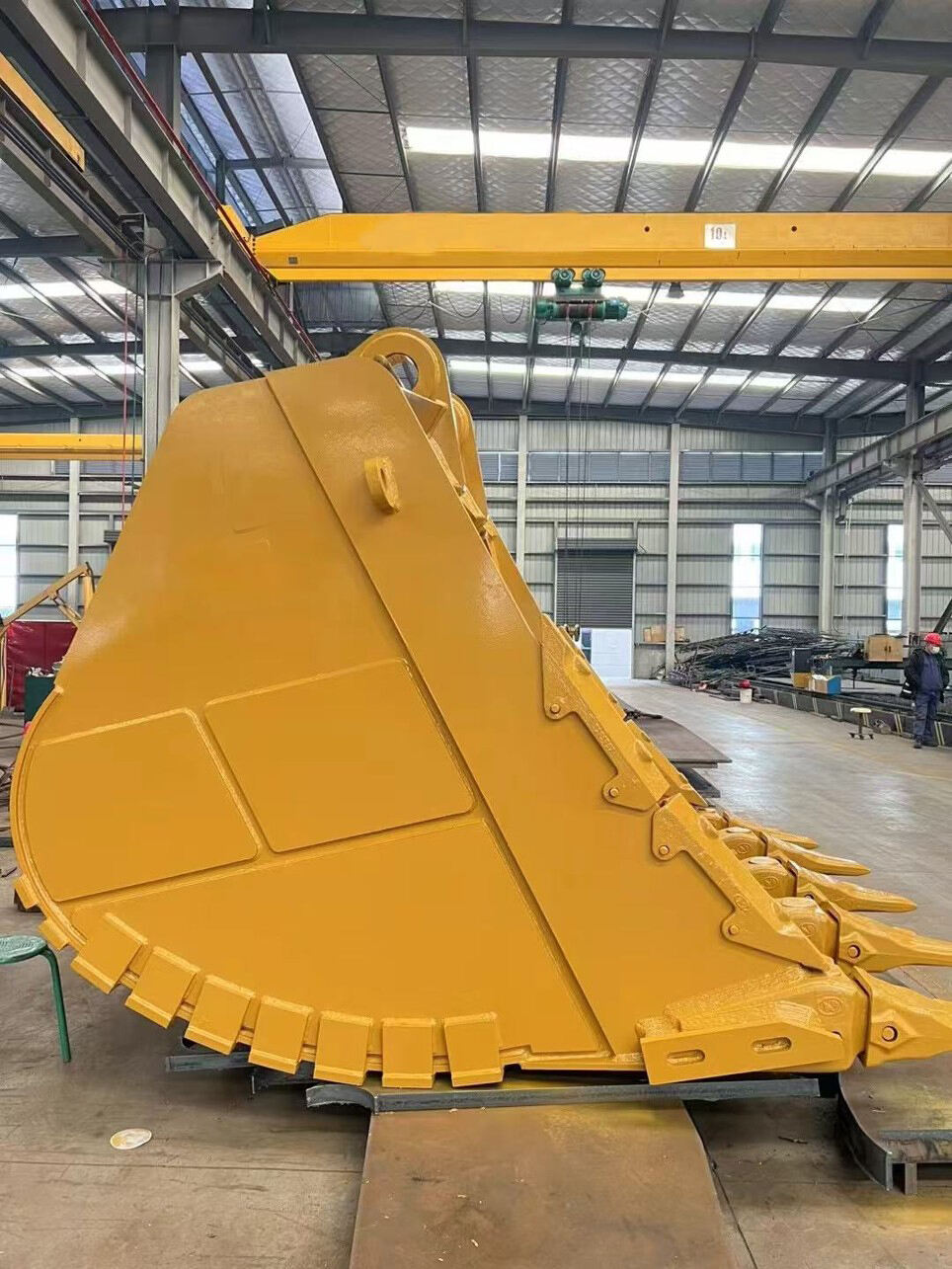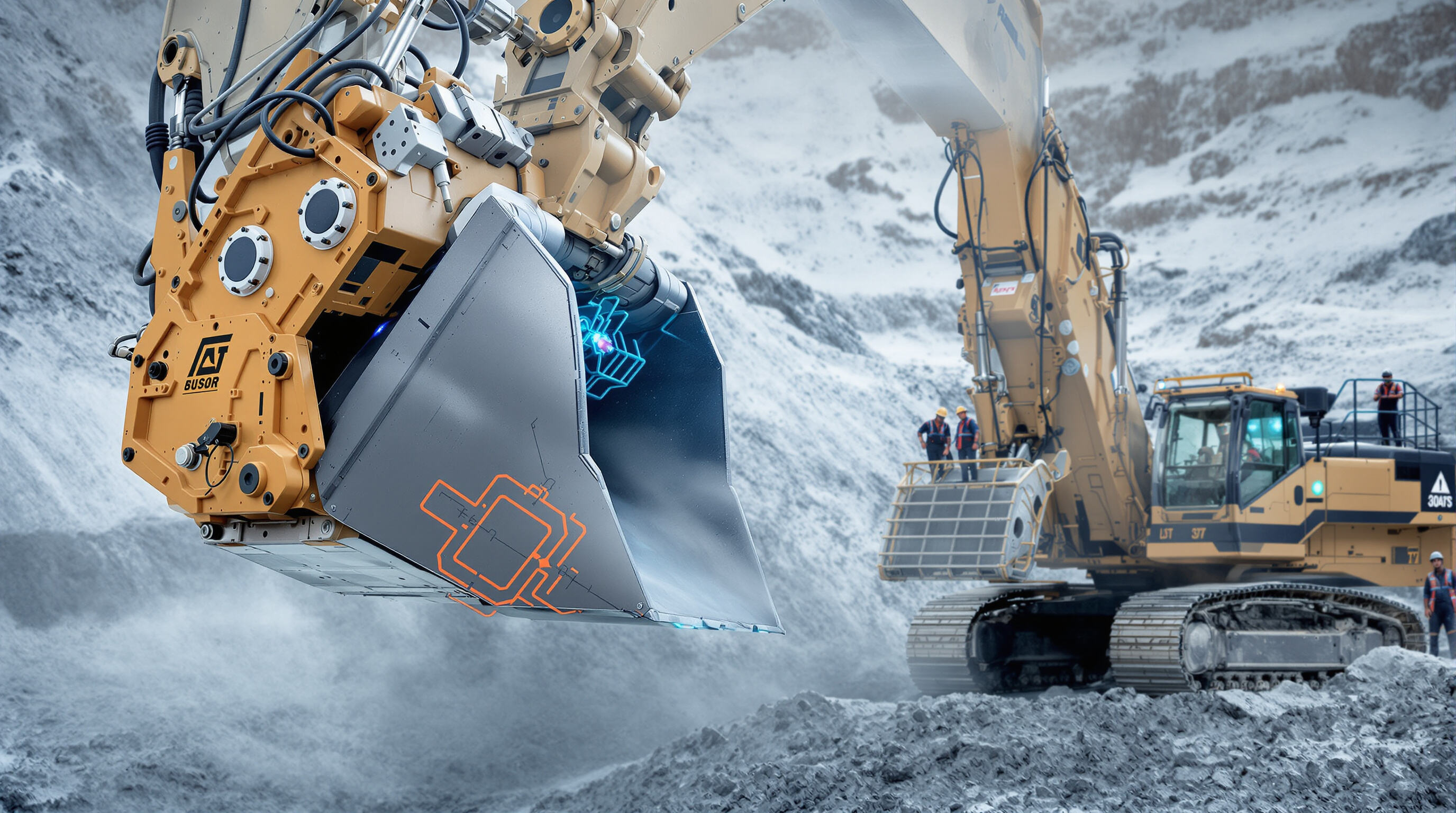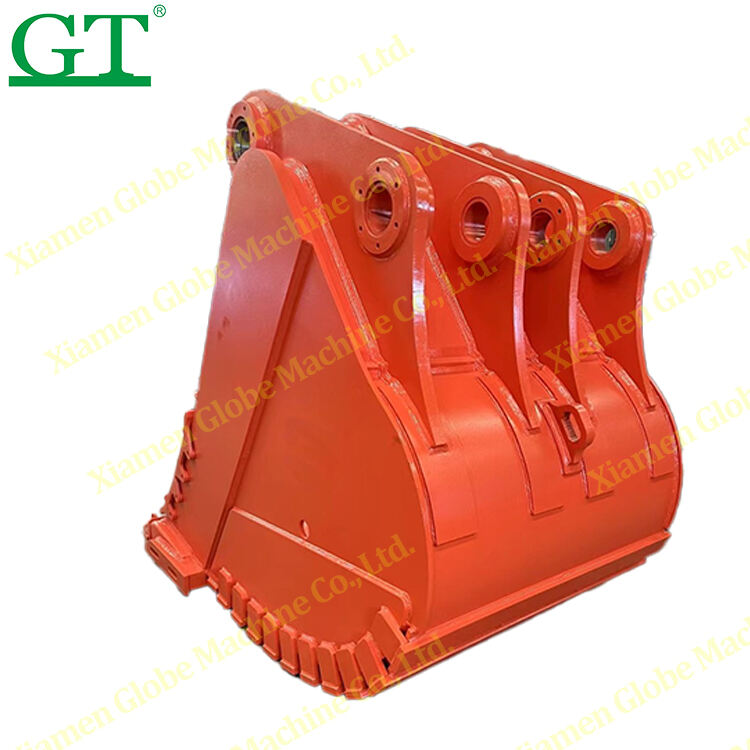What Are Mining Buckets and Why They Matter in Excavation
Mining buckets are those tough attachments that get bolted onto excavators and loaders. These tools are built to handle the rough stuff in mining operations and big earth moving projects. When it comes to getting work done efficiently, these buckets make all the difference in how much material gets moved around. A recent look at industry data from 2024 shows something interesting: when operators use buckets that match their specific needs, they can actually speed up loading cycles by around 22% over using whatever happens to be available. And this isn't just about digging faster either. Smart bucket selection helps protect the machines themselves from unnecessary wear and tear while keeping things flowing smoothly throughout the entire process from loading to transportation and final sorting stages.
How Bucket Design Impacts Digging Force, Material Retention, and Cycle Time

Three core design elements determine a bucket’s performance:
| Design Feature | Operational Impact | Efficiency Trade-off |
|---|---|---|
| Curvature & Rake Angle | Governs initial penetration depth | Steeper angles require more hydraulic force |
| Sideplate Reinforcement | Reduces deformation in abrasive environments | Adds 8–12% to bucket weight |
| Tooth Configuration | Enhances rock fragmentation efficiency | Increases wear on replaceable components |
Field trials show that rock-specific bucket profiles reduce cycle times by 15–18% in high-quartz deposits. However, operators must balance these gains against accelerated wear, particularly in high-impact environments.
The Connection Between Bucket Performance and Overall Productivity
How well a bucket fits with the material being handled and matches what the machine can do makes a real difference in how much gets done each day. Take those big 40 ton excavators used in copper mines for instance. When fitted with buckets specifically designed for ore, they managed to boost daily production by around 27% according to Mining Technology Review from last year. Good bucket design cuts down on stuff falling out while lifting and makes sure all that hydraulic power isn't wasted. These things matter when trying to hit or even beat those material handling goals that mining companies set themselves month after month.
Key Stat: A 2025 analysis of heavy-duty mining bucket applications found that reinforced sideplates reduced unplanned downtime by 34% in iron ore mining environments.
Types of Mining Buckets: Matching Design to Application
General-Purpose vs. Specialized Mining Buckets
Regular buckets work well when moving things like dirt or gravel around the job site because they're pretty versatile and don't break the bank. But there's another type worth considering too. Specialized buckets get built for tough situations where regular ones would wear out fast. Think about places with really rough materials or heavy stuff like certain types of ore that just tear through standard equipment. These specialized versions last longer and actually save time in the long run even though they cost more upfront. Most contractors find that while general purpose buckets make sense for smaller jobs or when switching tasks frequently, bigger operations where downtime is expensive tend to see better results investing in those specialized models despite paying extra at first.
Rock Buckets: Built for High-Impact Excavation in Tough Terrain
Rock buckets come equipped with reinforced side cutters plus integrated wear plates that give them extra strength against impacts from blasted rock formations. These specialized tools are commonly seen in copper mining operations as well as quarries around the world. Because they resist bending and warping so well, these buckets last longer between repairs and help avoid those frustrating unexpected breakdowns. According to various industry reports, when companies invest in purpose designed rock buckets rather than generic alternatives, they often see productivity gains reaching about 40% higher in really tough ground conditions where standard equipment would struggle.
Material-Specific Bucket Designs for Ore, Scrap, and Logs
- Ore buckets: Shallow profiles reduce spillage; cheek plates resist abrasive wear
- Scrap handlers: Shear-resistant steel alloys prevent tearing during debris handling
-
Logging grapples: Hydraulic rotators enable secure, hands-free timber manipulation
Material density is critical–ultra-heavy loads like magnetite ore require compact, reinforced designs to maintain machine stability and efficiency.
Grab Buckets: Clamshell and Four-Rope Designs for Bulk Handling
Clamshell buckets work really well when it comes to stockpiling stuff that flows freely like sand or gravel. They have two shells that come together to create a sort of sealed container, so nothing spills out while lifting vertically. The four rope versions get operated from cranes and give operators much better control because they can adjust both the hoisting and closing actions separately. These types of buckets see regular action at ports dealing with bulk cargo or in those big open pit mining operations where efficiency matters most. When selecting clamshells, engineers need to consider things like how dense the material is and whether it tends to stick together. Thicker shells might be needed for heavier materials, while certain jaw shapes perform better with sticky substances that don't want to let go easily.
Key Applications of Mining Buckets Across Mining Operations
Overburden Removal and Loading in Surface Mining
Getting rid of overburden efficiently really makes or breaks surface mining operations. Specialized buckets equipped with wear packages can boost strip rates by around 25% according to recent 2024 benchmark data. These improvements come from reinforced heel plates and better designed curves that just don't drag as much against the ground. The roll formed side cutters work wonders too when dealing with tough cemented gravel. They keep performing well without wearing down quickly, which means less material gets spilled onto haul trucks during loading. This translates directly into lower excavation costs per ton across different types of rock formations throughout矿业 operations.
Clamshell Grab Buckets in Open-Pit Mines and Stockyard Management
Clamshell grabs are really helpful in open pit mines and stockyards because they stop different materials from mixing together thanks to those twin shells working in sync. What makes them special is how they work mechanically with hydraulic power, allowing operators to control when stuff gets released. This careful handling cuts down on damage to things like iron ore pellets or processed coal, maybe around 18% less damage than regular buckets would cause. Another big plus? They keep operations running smoothly even when it's raining or the ground is damp, since normal equipment tends to get stuck or gummed up in wet conditions. The grab's accuracy means workers can mix materials properly and pick out specific layers without getting everything contaminated, which saves time and money in the long run for mining companies dealing with complex material storage challenges.
Four-Rope Grab Buckets for Crane-Based Bulk Material Handling
The four rope grab bucket system gives much better control at ports and during cargo transfers because it has separate ropes for lifting and closing. With this setup, operators can get really accurate discharges all around the clock, which matters a lot when dealing with tricky materials such as scrap metal or copper concentrates. Cycle times actually drop by about 22 percent according to recent studies from bulk handling reports in 2025. These grabs also feature double sheave pulleys that stop cables from coming off track during those big movements when unloading ships. Plus there are replaceable wear strips built right in, so they last longer against harsh conditions. All these features together help cut down how long vessels need to stay docked, saving money for terminal operators.
How to Select the Right Mining Bucket for Your Equipment and Environment
Matching Bucket Type to Material Characteristics and Density
What kind of material we're dealing with really determines what type of bucket should be used. Cohesive clays that measure under 2900 psi tend to stick together a lot, so operators find curved profile buckets work wonders in preventing all that messy buildup. When handling heavy stuff like iron ore which weighs around 5.5 tons per cubic meter, it's actually better to go with smaller capacity rock buckets because they hold up much better structurally. The mining industry has learned this the hard way after seeing standard buckets fail under such extreme loads. For those working in silica rich environments where everything is super abrasive, switching to Hardox 500 steel specifically at the wear points makes a huge difference compared to regular AR400 steel. We've seen service life double in these conditions. And then there's the whole question of lightweight versus heavy materials. Light aggregates let us fit about 30% more into each load, but when dealing with dense ores, operators need to pay close attention to how weight is distributed across the machine otherwise the hydraulics just can't handle it anymore.
Excavator Compatibility: Bucket Size, Capacity, and Machine Reach
The power class of an excavator really does set practical limits for what kind of bucket it can handle effectively. Machines in the 350 to 600 horsepower range generally work best with rock buckets between 1.8 and 4.6 cubic meters. Going beyond the hydraulic capacity by even 15% can push cylinder stress up around 45%, which means parts start wearing out much faster than expected. When it comes to arm length, matching it to the required dump height makes all the difference. Most standard 6 meter arms still manage to keep about 80% of their digging power when extended fully. And don't forget about bucket width either. If the bucket gets too wide relative to the machine's base dimensions, especially anything over 85% of that base width, operators will notice serious stability issues when working on sloped ground.
Operating Conditions: Dealing with Abrasive Soils, Moisture, and Impact Stress
When working in dry areas full of silica, equipment makers have found that buckets equipped with replaceable side cutters along with durable base plates last much longer before needing replacement. Moist environments tell a different story though. Here, machines need those special hydraulic drainage channels built right into them. These channels help cut down on all that annoying sticky stuff clinging to surfaces, probably around half less than without them. Rock that's broken up into smaller pieces requires something else entirely. Triple welded gussets placed strategically at the stress points really stand up better against impacts during operation. And let's not forget about those super hot or cold conditions where regular welds just won't hold. Using crack resistant welding techniques with ESAB OK Aristorod electrodes makes sure the joints stay intact even when things get really tough out there in the field.
Standard vs. Custom Bucket Designs: Cost, Lead Time, and Scalability
| Factor | Standard Buckets | Custom Designs |
|---|---|---|
| Unit Cost | $12k–$65k | $28k–$120k+ |
| Lead Time | 3–15 days | 4–12 weeks |
| Scalability | Immediate availability | Project-specific tooling |
| Wear Life Extension | 10–15% over basic models | 40–75% in optimal scenarios |
Standard buckets suit consistent, homogeneous operations. Custom designs justify higher costs in complex ore bodies with mixed densities by enabling faster cycles and longer service life.
Innovations and Future Trends in Mining Bucket Technology

Wear-Resistant Materials and Hard-Facing Technologies in Rock Buckets
The latest rock buckets feature protection layers made from boron strengthened steel combined with chromium carbide coatings, giving components roughly 40 to 60 percent longer life when working in really abrasive conditions. The materials hold up against constant grinding forces without losing their strength even after thousands of impacts. What makes these buckets stand out? The special bonding process stops those annoying layers from peeling apart, something operators dread in tough granite quarries. Looking at the bigger picture, these improvements cut down on how often parts need replacing. Mining companies typically spend around 740 thousand dollars on replacements over time according to recent industry reports.
Smart Buckets: Load Monitoring, Telemetry, and Performance Analytics
Smart buckets equipped with IoT technology actually come with built-in strain gauges plus gyroscopes that track how hard it is digging through material, what angle the bucket enters at, and where weight gets distributed across the bucket during operation. The telemetry system sends all this information to some pretty advanced algorithms which help boost overall efficiency somewhere around 18 to maybe even 22 percent. When these smart buckets detect unusual stress patterns, they send alerts so maintenance crews can jump on problems before things break down completely. Looking at all this data over time shows operators where they might cut down on cycle times or figure out when those worn teeth really need replacing instead of just following a fixed schedule.
Sustainable Developments: Lightweight Structures and Recyclable Components
New composite materials like carbon fiber reinforced polymers are changing the game for equipment manufacturers. These advanced materials deliver similar strength to steel but weigh around 70 percent less, which cuts down on fuel burn and lowers emissions across the board. When applied to construction machinery, lighter buckets mean better performance from hydraulic systems, particularly noticeable in those big shovel type excavators working on job sites daily. The environmental benefits keep stacking up too. Many companies have started designing with modular parts that snap together easily, making it much simpler to take apart old equipment when it reaches end of life. Some top brands in the industry have even ramped up their green credentials by adopting closed loop manufacturing techniques where they can incorporate nearly 92% recycled metal content into brand new bucket designs. This kind of approach helps reduce waste while maintaining quality standards.
FAQ
What are mining buckets?
Mining buckets are attachments for excavators and loaders that are designed to handle mining operations and large earth-moving tasks efficiently.
How does bucket design affect operational efficiency?
Design elements like curvature, sideplate reinforcement, and tooth configuration influence the bucket's performance, affecting factors like digging force, material retention, and cycle time.
Why are specialized mining buckets beneficial?
Specialized mining buckets are designed for challenging environments and materials, offering longer durability and increased efficiency despite higher upfront costs.
What innovations are present in modern mining buckets?
Modern mining buckets may feature wear-resistant materials, IoT technology for load monitoring, and sustainable components to increase efficiency and reduce environmental impact.
Table of Contents
- What Are Mining Buckets and Why They Matter in Excavation
- How Bucket Design Impacts Digging Force, Material Retention, and Cycle Time
- The Connection Between Bucket Performance and Overall Productivity
- Types of Mining Buckets: Matching Design to Application
- Key Applications of Mining Buckets Across Mining Operations
- How to Select the Right Mining Bucket for Your Equipment and Environment
- Innovations and Future Trends in Mining Bucket Technology
- FAQ




